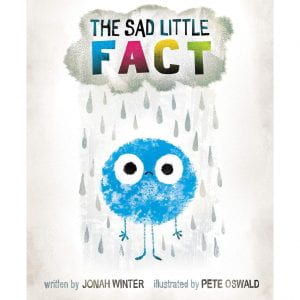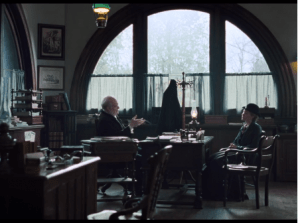 The Sad Little Fact by Jonah Winter is a whimsical, yet poignant and very contemporary commentary about who decides what is fact and what may be shared as “facts” as determined by the “authorities”. Pete Oswald effectively portrays the authorities as long-legged, red fisted partial torso figures. The burying of facts is both a literal and figurative image which sparks conversation and controversy.
The Sad Little Fact by Jonah Winter is a whimsical, yet poignant and very contemporary commentary about who decides what is fact and what may be shared as “facts” as determined by the “authorities”. Pete Oswald effectively portrays the authorities as long-legged, red fisted partial torso figures. The burying of facts is both a literal and figurative image which sparks conversation and controversy.
Over the past two weeks, I’ve had the pleasure of cracking the spine of this picture book for all of our grade 3 – 8 learners. Each conversation reached a different depth of discussion that I had not anticipated. I credit that complexity to our educators who, on a regular basis, are providing our students with opportunities to use and strengthen their critical thinking skills as it relates to information consumption. Our students are very versed in how to ensure that multiple, reliable sources are used while researching topics and they easily and authentically pose, “I wonder” statements when pondering information.
Entering into this Read Aloud “tour”, I had anticipated a conversation about global warming, as the story line leads the reader down that road, but I had not anticipated the rich and impassioned conversations about residential schools, Google Home devices and processed foods to name but a few. In most classes we were also to also refine the conversation from an initial global perspective to a local one, as we discussed how we all need to be “fact finders” instead of blindly believing others ~ whether we are researching life on other planets or school yard misunderstandings. Our conversations even included some clever connections such as the wondering if the “facts” were developed/created in a “fact’ory. Needless to say, our students are rarely passive consumers of good quality texts. They actively engage in each experience.
As I normally find when I venture on one of my school-wide Read Aloud tours, each introduction to the book becomes more powerful as the thoughts and ideas from previous classroom discussions enhance each subsequent one. It seems to take more and more time for me to get to the first word in the story. For this tour, we found that the biographical information about the author created the opportunity for lots of background knowledge building. We were intrigued by Winter’s reluctance for a social media presence; especially as an author in 2020. Yet, as we finished the story, our students had effectively drawn the connection between how he depicted the “authorities” and the factory-like assembly line creation of fake facts and his reluctance to join the world of social media.
On the same day that I completed my final read aloud of “The Sad Little Fact”, I received an unexpected invitation to join a friend and see ‘Little Women”, Greta Gerwig’s current adaptation of Louisa May Alcott’s 1868 classical tale of the four March sisters. I found the movie emotionally riveting from beginning to end, through all of the timeline variations (I was thankful at times for Jo’s change of hairstyle as it aided in my confirmation of where we were in and in which storyline). It was one of those movies that I will undoubtedly enjoy again, but with a pen and paper close by ~ as the richness of the dialogue needs to be appreciated a second time. Having said that, there was one quote that didn’t need tools to document it, in order to remember it, as it resonated in my mind, as soon as it was articulated in the film. “Writing doesn’t confer importance, it reflects it”
And there is was ~ that serendipitous moment of connection between “The Sad Little Fact” and “Little Women”. Could it be that both Greta Gerwig, through the character of Jo Marsh, and Jonah Winter were both using their words to warn us of the perils of the written word and our current abandonment of authenticity? It is becoming increasingly challenging to decipher fact from fiction. Gone are the days that we could unequivocally trust that the written word was indeed factual? We are bombarded with “fake news” and it is becoming more and more challenging to know what is fact and what is fiction.
 I love how Gerwig portrays the stand-off between Jo and her editor to emphasize that very point. “The right ending is the one that sells”, he states, when Jo blatantly answers, “She doesn’t marry either of them”.
I love how Gerwig portrays the stand-off between Jo and her editor to emphasize that very point. “The right ending is the one that sells”, he states, when Jo blatantly answers, “She doesn’t marry either of them”.
So….is all lost? Or is this a call to action? What is our role as educators when it comes to teaching our students about how to distinguish between fact and fiction?
Come write with me…..
